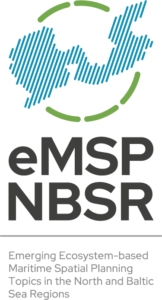Digital technologies in maritime spatial planning – smoother information exchange and better usability
 Finland’s maritime spatial plan 2030 is only available in digital form. Work is underway to harmonise the material at the national and international levels. Senior Ministerial Adviser Maaret Stenström is involved in considering digital solutions and usability in maritime spatial planning.
Finland’s maritime spatial plan 2030 is only available in digital form. Work is underway to harmonise the material at the national and international levels. Senior Ministerial Adviser Maaret Stenström is involved in considering digital solutions and usability in maritime spatial planning.
Finland’s maritime spatial plan 2030 was prepared entirely in digital form, and Finland was the first country on the Baltic Sea to accomplish this. The plan map is functional and interactive, providing information about planning solutions and access to the background materials used in the planning and descriptions of the symbols. This was a pioneering solution, but it also required a great deal of work from the people who made it.
 “When the maritime spatial planning information model was prepared in geoinformation format, the national and international requirements and needs applying to classification and other data needed to be taken into account,” Maaret Stenström says.
“When the maritime spatial planning information model was prepared in geoinformation format, the national and international requirements and needs applying to classification and other data needed to be taken into account,” Maaret Stenström says.
In early 2022, a logical information model was prepared for the maritime spatial plan on an interoperability platform, and life cycle and quality rules were drawn up for the maritime spatial plan information model. The interoperability platform is maintained by the Digital and Population Data Services Agency, and it enables different authorities to produce information. The Ministry of the Environment delivers information on topics such as town planning and maritime spatial planning in relation to its own administrative branch.
“The maritime spatial plan is a plan on how areas will be used. Making such a plan in the form of an information model is a prerequisite for promoting the efficient exchange of information between the authorities and other actors. The logical information model presents information about the maritime spatial planning area and its characteristics and connections. Even the vocabulary used should be considered carefully to ensure, for example, that all authorities have the same understanding of the concept of maritime spatial planning,” emphasises Stenström.
The work that has now been done to create an information model will lay the foundation for transferring the maritime spatial plan to the Information System for the Built Environment (RYTJ), which is currently in preparation. This new system will host the town planning and design files specified in the Land Use and Building Act, as well as information about building permits. The new information system is expected to be deployed in phases in 2023 and 2024.
“The maritime spatial plan is also part of Finland’s maritime information, so it is important to provide access to the maritime spatial plan material via less official channels, such as the MarineFinland.fi website. The service is an internationally unique entity that is recognised for its ease of use. It presents, among other things, all the information collected on underwater marine nature with the help of the VELMU programme, which has been operating for well over a decade,” says Stenstrom.
National and international compatibility poses a challenge for the digital approach to maritime spatial planning. The Maritime Spatial Planning Directive obliges different countries to coordinate their maritime spatial plans and use and coordinate the best possible information in different maritime areas. In the Baltic Sea, the Data Group, operating under the HELCOM-VASAB Working Group on Maritime Spatial Planning, has been working towards this common goal since 2015. The work will continue at least until the end of 2024.
“International data coherence is a demanding job. Countries have different maritime spatial planning systems and resources. Coordination is a demanding task – compromises and fine-tuning have been and will be required. The outcome is the Basemaps service, which is a fine example of successful collaboration,” says Stenström.
“One of the most important aspects of Basemaps is the output function, which fits plans from different countries together in the same mould, making it possible to view the areas that have been identified, designated or reserved for maritime activities in different plans using a single platform. National boundaries do not constrain maritime activity – for example, maritime traffic routes pay no attention to borders at all. The planning solutions, such as the impacts of offshore wind farms, go beyond national borders. Therefore, sustainable planning demands cross-border consideration of the planning solutions, and Basemaps lays a strong foundation for this,” says Stenström. The Basemaps query function also makes it possible to see which subject areas different countries have included in their plans. This can reveal which countries have, for example, covered aquaculture in their plans.
There is also a Guide available for Basemaps, providing detailed guidance on how to use the application. The data coherence work is not limited to the Baltic Sea region; indeed, the first steps have already been taken towards a joint platform covering all of Europe, including maritime spatial plans. Finland has been on the front line of the EMODnet service, and the plan can be viewed together with plans from Belgium, Denmark, Latvia and Poland. We are looking forward to seeing plans from other countries on the same platform.
Finland’s maritime spatial planners and the other parties responsible for maritime spatial planning in the Baltic Sea and the North Sea are involved in the ongoing eMSP NBSR project, in which one of the main actions is to promote the coherence and harmonisation of cross-border maritime spatial planning and maritime spatial plan data. The Data Sharing work is led by the French Naval Hydrographic and Oceanographic Service (SHOM).
Basemaps, https://basemaps.helcom.fi/
Basemaps Guide, detailed instructions on how to use Basemaps, https://maps.helcom.fi/website/docs/BASEMAPS_Instructions_Admin.pdf
Digital Maritime Spatial Plan for Finland 2030, www.merialuesuunnitelma.fi
European Marine Observation and Data Network (EMODnet), https://www.emodnet-humanactivities.eu/view-data.php
Interoperability of information in the built environment, Ministry of Environment, https://ym.fi/en/project?tunnus=YM023:00/2022
Website of the Data Sharing, Information & Communication Technologies Serving MSP eMSP NBSR project, which is part of the eMSP NBSR project, https://www.emspproject.eu/project-activities/community-of-practice/data-sharing/


